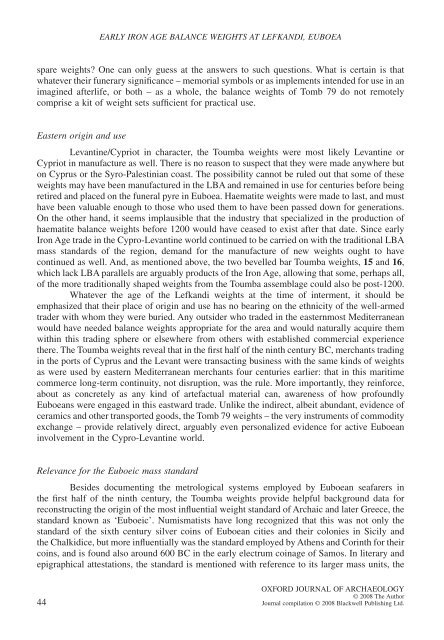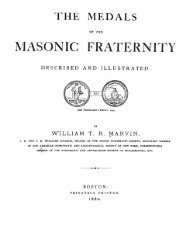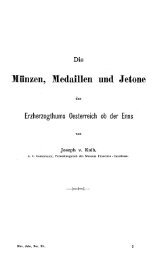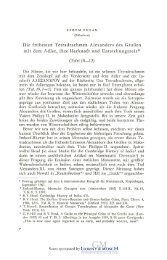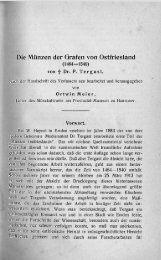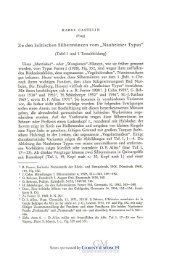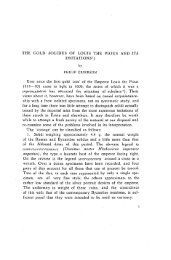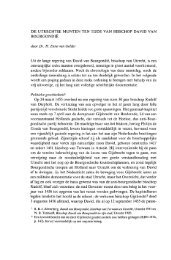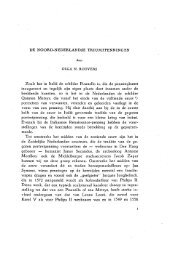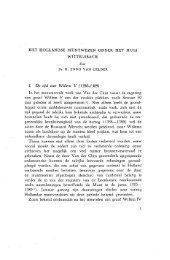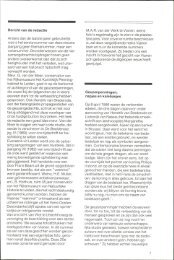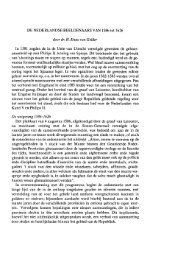Early Iron Age balance weights at Lefkandi, Euboea
Early Iron Age balance weights at Lefkandi, Euboea
Early Iron Age balance weights at Lefkandi, Euboea
Create successful ePaper yourself
Turn your PDF publications into a flip-book with our unique Google optimized e-Paper software.
EARLY IRON AGE BALANCE WEIGHTS AT LEFKANDI, EUBOEA<br />
spare <strong>weights</strong>? One can only guess <strong>at</strong> the answers to such questions. Wh<strong>at</strong> is certain is th<strong>at</strong><br />
wh<strong>at</strong>ever their funerary significance – memorial symbols or as implements intended for use in an<br />
imagined afterlife, or both – as a whole, the <strong>balance</strong> <strong>weights</strong> of Tomb 79 do not remotely<br />
comprise a kit of weight sets sufficient for practical use.<br />
Eastern origin and use<br />
Levantine/Cypriot in character, the Toumba <strong>weights</strong> were most likely Levantine or<br />
Cypriot in manufacture as well. There is no reason to suspect th<strong>at</strong> they were made anywhere but<br />
on Cyprus or the Syro-Palestinian coast. The possibility cannot be ruled out th<strong>at</strong> some of these<br />
<strong>weights</strong> may have been manufactured in the LBA and remained in use for centuries before being<br />
retired and placed on the funeral pyre in <strong>Euboea</strong>. Haem<strong>at</strong>ite <strong>weights</strong> were made to last, and must<br />
have been valuable enough to those who used them to have been passed down for gener<strong>at</strong>ions.<br />
On the other hand, it seems implausible th<strong>at</strong> the industry th<strong>at</strong> specialized in the production of<br />
haem<strong>at</strong>ite <strong>balance</strong> <strong>weights</strong> before 1200 would have ceased to exist after th<strong>at</strong> d<strong>at</strong>e. Since early<br />
<strong>Iron</strong> <strong>Age</strong> trade in the Cypro-Levantine world continued to be carried on with the traditional LBA<br />
mass standards of the region, demand for the manufacture of new <strong>weights</strong> ought to have<br />
continued as well. And, as mentioned above, the two bevelled bar Toumba <strong>weights</strong>, 15 and 16,<br />
which lack LBA parallels are arguably products of the <strong>Iron</strong> <strong>Age</strong>, allowing th<strong>at</strong> some, perhaps all,<br />
of the more traditionally shaped <strong>weights</strong> from the Toumba assemblage could also be post-1200.<br />
Wh<strong>at</strong>ever the age of the <strong>Lefkandi</strong> <strong>weights</strong> <strong>at</strong> the time of interment, it should be<br />
emphasized th<strong>at</strong> their place of origin and use has no bearing on the ethnicity of the well-armed<br />
trader with whom they were buried. Any outsider who traded in the easternmost Mediterranean<br />
would have needed <strong>balance</strong> <strong>weights</strong> appropri<strong>at</strong>e for the area and would n<strong>at</strong>urally acquire them<br />
within this trading sphere or elsewhere from others with established commercial experience<br />
there. The Toumba <strong>weights</strong> reveal th<strong>at</strong> in the first half of the ninth century BC, merchants trading<br />
in the ports of Cyprus and the Levant were transacting business with the same kinds of <strong>weights</strong><br />
as were used by eastern Mediterranean merchants four centuries earlier: th<strong>at</strong> in this maritime<br />
commerce long-term continuity, not disruption, was the rule. More importantly, they reinforce,<br />
about as concretely as any kind of artefactual m<strong>at</strong>erial can, awareness of how profoundly<br />
<strong>Euboea</strong>ns were engaged in this eastward trade. Unlike the indirect, albeit abundant, evidence of<br />
ceramics and other transported goods, the Tomb 79 <strong>weights</strong> – the very instruments of commodity<br />
exchange – provide rel<strong>at</strong>ively direct, arguably even personalized evidence for active <strong>Euboea</strong>n<br />
involvement in the Cypro-Levantine world.<br />
Relevance for the Euboeic mass standard<br />
Besides documenting the metrological systems employed by <strong>Euboea</strong>n seafarers in<br />
the first half of the ninth century, the Toumba <strong>weights</strong> provide helpful background d<strong>at</strong>a for<br />
reconstructing the origin of the most influential weight standard of Archaic and l<strong>at</strong>er Greece, the<br />
standard known as ‘Euboeic’. Numism<strong>at</strong>ists have long recognized th<strong>at</strong> this was not only the<br />
standard of the sixth century silver coins of <strong>Euboea</strong>n cities and their colonies in Sicily and<br />
the Chalkidice, but more influentially was the standard employed by Athens and Corinth for their<br />
coins, and is found also around 600 BC in the early electrum coinage of Samos. In literary and<br />
epigraphical <strong>at</strong>test<strong>at</strong>ions, the standard is mentioned with reference to its larger mass units, the<br />
44<br />
OXFORD JOURNAL OF ARCHAEOLOGY<br />
© 2008 The Author<br />
Journal compil<strong>at</strong>ion © 2008 Blackwell Publishing Ltd.


